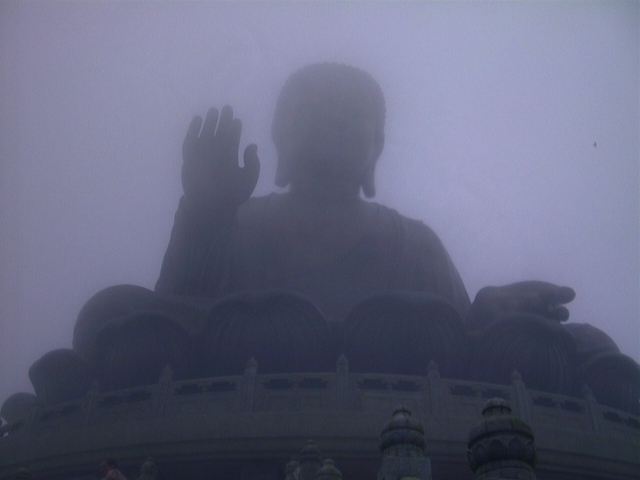
(5th/6th century CE)
Bodhidharma is credited with bringing Zen Buddhism to China and he is the First Patriarch of Chinese Zen Lineage. He was born on Oct. 5th. (Chinese Lunar Calendar) in Southern India, and was the third son of an Indian King; the royal family belonged to the Bhramin caste. Bodhidharma's Buddhist Master, Prajnatara, a woman master in eastern India was the 27th Patriarch of Indian Buddhism, taught Bodhidharma for many years, gave him Mind Transmission, made him the 28th Patriarch, and gave him the name Bodhidharma.[1] Following the instruction of his Master to transmit Dharma to China, Bodhidharma traveled east to Southern China in 526 A.D. When he arrived in Kwang Chou, he was ceremoniously welcomed and greatly honored by the local military official named Shao Yang. The same year, he was invited to the Capitol, Nanjing, to meet Emperor Wu Di of the Liang dynasty. Because the communication between the Emperor and Bodhidharma was mutually unsatisfactory, Bodhidharma left the palace, crossed the Yangtzu River, and continued north until he arrived at the Shao Lin Temple in Ho Nan Province. It was here that Bodhidharma became famous for meditating 9 years facing a wall.
After he gave his disciple, Hui K'o, the Robe, Begging Bowl, Lankavatara Sutra, and Mind Transmission, Bodhidharma went to Chen Sung (One Thousand Saints) Temple to propagate the Dharma. He passed into Nirvana in 536 A.D., was buried in Shon Er Shan (Bear Ear Mountain) in Ho Nan, and a stupa was built for him in Pao Lin Temple. Later, the Tang dynasty Emperor, Dai Dzong, bestowed on Bodhidharma the name Yuen Che Grand Zen Master, and renamed his stupa as Kong Kwan (Empty Visualization).
- Bodhidharma's Teachings:
- Bodhidharma instructed his disciples that the Lankavatara Sutra be used to seal the mind. The method of cultivating practice transmitted by Bodhidharma pointed out that we should pay attention closely to this important sutra. His major teaching is there are two paths to enter Dharma Gate: Study and Practice. Study: through the study of Buddhist sutras and scriptures, you will understand Buddha Nature. Your Buddha Nature doesn't manifest because it is clouded by defilements, such as: greed, attachment, passion, aggression and ignorance. Practice: when you follow Buddhist principles in your daily life, you discover that your Buddha Nature is equal to the Buddha's.
- Bao Yen Hsin: The willingness to accept, without complaining, suffering and unhappiness because you understand it is your own karma.
- Sui Yen Hsin: Understanding that all situations are the consequences of karmic causes, and therefore, you maintain equanimity in all circumstances, both negative and positive.
- Tsung Fa Hsin: Realizing through practice the essence of your Buddha Nature, which is equanimity.
ZEN AND THE TRANSMISSION OF SPIRITUAL POWER
SRI RAMANA MAHARSHI: THE LAST AMERICAN DARSHAN
RECOUNTING A YOUNG BOY'S NEARLY INSTANT TRANSFORMATION INTO THE ABSOLUTE DURING HIS ONLY DARSHAN WITH THE MAHARSHI
BUDDHISM IN AMERICA BEFORE COLUMBUS
THE CODE MAKER, THE ZEN MAKER
OF SHANGRI-LA, SHAMBHALA, GYANGANJ, BUDDHISM AND ZEN
HUI SHEN: BHIKSHU
Fundamentally, our experience as experienced is not different from the Zen master's. Where
we differ is that we place a fog, a particular kind of conceptual overlay onto that experience
and then make an emotional investment in that overlay, taking it to be "real" in and of itself.
(PLEASE CLICK)
ZEN ENLIGHTENMENT IN A NUTSHELL
30 MINUTES TO ENLIGHTENMENT
CODE OF ETHICS FOR SPIRITUAL GUIDES
SPIRITUAL GUIDES: PASS OR FAIL?
CLICK
HERE FOR
ENLIGHTENMENT
ON THE RAZOR'S
EDGE
SEE ALSO:
T'ANG CH'AN AND THE MYTH OF BODHIDHARMA
MAJOR HISTORICAL BUDDHIST MASTERS, ZEN ANCESTORS AND ZEN PATRIARCHS
Bodhidharma, Hui'ko, Hui Shen, Hui Neng, Shih-t'ou Hsi-ch'ien, Zhaozhou, Moshan Liaoran,
Mugai Nyodai, Nagarjuna, Ganapati Muni, Kuan Yin, Tung-Shan, Te Shan, Dogen
FOOTNOTE [1]
The following is from the works of Rev. Koten Benson found in the source so cited:
"The knowledge that Bodhidharma had a woman master seems to have been lost in China after a few generations, because in written Chinese, gender is inferred from context rather than stated explicitly. Praj˝atara's gender and details about her life have been established from three different sources. First, archeological discoveries have confirmed the existence of this great woman teacher in southern India. Second: the historical and oral traditions of the people of the state of Kerala provide details about the lives of both Praj˝atara and Bodhidharma. Third, information transmitted through the Zen lineages of Korea confirm the information."
(source)



